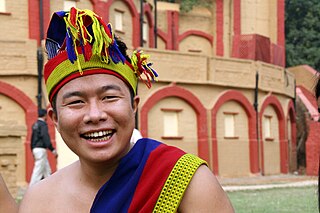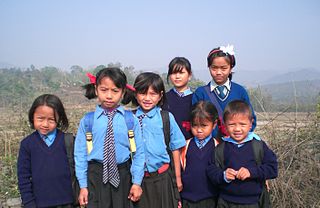Related Research Articles

Nagaland is a landlocked state in the northeastern region of India. It is bordered by the Indian states of Arunachal Pradesh to the north, Assam to the west, Manipur to the south, and the Sagaing Region of Myanmar (Burma) to the east. Its capital city is Kohima and its largest city is the twin Chümoukedima–Dimapur. The state has an area of 16,579 square kilometres (6,401 sq mi) with a population of 1,980,602 as per the 2011 Census of India, making it one of the smallest states in India.

The Tangshang people, also known as the Tangsa Naga, are a Tibeto-Burmese ethnic group inhabiting the Northeast Indian states of Arunachal Pradesh and Assam, and across the border in Sagaing Region and parts of Kachin State of Myanmar. The Tangshang people in Myanmar were formerly known as Rangpang, Pangmi, and Heimi/Haimi. Tangshang/Tangsa is the largest Naga ethnic group having an approximate population of 450,000. Their language is called Naga-Tase in the Ethnologue and Tase Naga in the ISO code (ISO639-3:nst). They are a scheduled group under the Indian Constitution and there are many sub-groups within Tangsa on both sides of the border.

The Nagas are various ethnic groups native to northeastern India and northwestern Myanmar. The groups have similar cultures and traditions, and form the majority of population in the Indian states of Nagaland and Manipur and Naga Self-Administered Zone of Myanmar; with significant populations in Arunachal Pradesh and Assam in India; Sagaing Region and Kachin State in Myanmar (Burma).

Talimeren Ao was an Indian footballer and physician from Nagaland. He is best known as the captain of the India national football team in their first ever match after independence. One of the most famous Nagas, he was a figurehead of India's football history, and his name is resonant in the collective memory of the people. He played domestic club football for Mohun Bagan.

The Tangkhul people, also known as the Tangkhul Naga, are a Tibeto-Burmese ethnic group living in the Indo–Mayanmar border area, occupying the Ukhrul district and Kamjong district in the Northeast Indian state of Manipur, and in parts of neighboring Myanmar. Despite this international border, many Tangkhul have continued to regard themselves as "one nation". The name "Tangkhul" is originated from the Meitei language words, "Tang" meaning "scarce" and "Khul" meaning "village" respectively. According to another theory of origin, the term "Tangkhul" is derived from "Thankhul", meaning "Than village" in Meitei language.
South Asian ethnic groups are an ethnolinguistic grouping of the diverse populations of South Asia, including the nations of India, Pakistan, Bangladesh, Nepal, Bhutan, the Maldives, and Sri Lanka. While Afghanistan is variously considered to be part of both Central Asia and South Asia, Afghans are generally not included among South Asians.
The Naga languages are a geographic and ethnic grouping of languages under the Kuki-Chin-Naga languages, spoken mostly by Naga peoples.

The National Socialist Council of Nagaland (NSCN) is a Naga nationalist and separatist group operating mainly in Northeast India, with minor activities in northwest Myanmar (Burma). The main aim of the organisation is to establish a sovereign Naga state, "Nagalim", which would consist of all the areas belonging to the Naga people in Northeast India and northwest Myanmar. The NSCN's slogan is "Nagaland for Christ".
Hkamti District or Khamti District is a district in northern Sagaing Division of Burma (Myanmar). Its administrative center is the town of Singkaling Hkamti.

The Naga Self-Administered Zone, is a self-administered zone in the Naga Hills area of Sagaing Region of Myanmar. Its administrative seat is the town of Lahe.

Yimkhiung is a Naga ethnic group whose traditional territory includes Shamator and Kiphire District in the Indian state of Nagaland and western areas of Burma.

Lamkang is a Tibeto-Burman language of Southern Naga linguistic sub branch. It is spoken by the Lamkang Nagas of Manipur, India, with one village in Burma. The Lamkangs mostly live in the southwest and southeastern parts of Manipur.
Vizol Vitso-n Koso was an Indian politician from Nagaland who served as the 4th Chief Minister of Nagaland twice from February 1974 until March 1975 and November 1977 until April 1980. He became the Chief Minister of Nagaland as part of the United Democratic Front (Nagaland).

The Anāl are some of the oldest settlers of the present day Manipur. They belong to the Naga tribe native to Manipur state in North-East India and part of Myanmar. The name "Anal" was given by the Meitei people of Manipur valley. They are listed as a Scheduled Tribe, in accordance with The Scheduled Castes and Scheduled Tribes Orders (Amendment) Act, 1976 Indian Constitution. The Anāl tribe is one of the 'sixty six Naga tribes' of the Naga ancestral homeland. The members of this tribe are found both in India and Myanmar. In India, they are situated in the States of Manipur and Nagaland but mostly concentrated in the former. In the State of Manipur, the Anāl Naga population concentrated in Chandel and a few Anāl villages are located in its neighbouring districts, Churachandpur district has about three villages and Thoubal district has one or two.
Khriehu Liezietsu is an Indian politician and MLA of the Nagaland Legislative Assembly and is the Parliament Secretary for Youth Resources and Sports, State Lotteries and Music Task Force in Nagaland Government. He belongs to Naga People's Front Party and has won the election from Northern Angami I Assembly constituency.
The Moyon people, also known as Bujuur people or the Moyon Naga, are a Tibeto-Burmese ethnic group predominantly resides in the Northeast Indian state of Manipur and, some in Sagaing Region in Myanmar. They are listed as a Scheduled Tribe (STs) by India. They share close cultural and linguistic affinity with Monsang people.

The hill tribes of Northeast India are hill people, mostly classified as Scheduled Tribes (STs), who live in the Northeast India region. This region has the largest proportion of scheduled tribes in the country.
The Makury tribe is one of the Naga tribes that mostly resides in Naga Self-Administered Zone in Myanmar and some in Nagaland, India. They are one of the major Naga tribes of Myanmar and mostly inhabits around Lay Shi Township in Myanmar. However, in India due to lack of official recognition from Government of Nagaland are considered sub-tribe of Yimkhiung Nagas.
The Lainong people, also known as the Lainong Naga, are a Tibeto-Burmese ethnic group that mostly resides in Naga Self-Administered Zone in Myanmar. They are one of the major Naga ethnic group of Myanmar and mostly inhabiting the Lahe and Hkamti Townships in Myanmar.
References
- ↑ S. R. Tohring (2010). Violence and identity in North-east India: Naga-Kuki conflict. Mittal Publications. pp. xv–xvii. ISBN 978-81-8324-344-5.
- ↑ "NAGAS IN MYANMAR: PEOPLE OF THE FORGOTTEN LAND | morungexpress.com". morungexpress.com.
- ↑ Aung, Oliver Slow, Win Zar Ni (7 August 2019). "Nagaland: making peace in a divided homeland". Frontier Myanmar.
